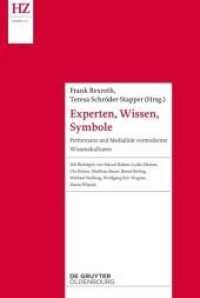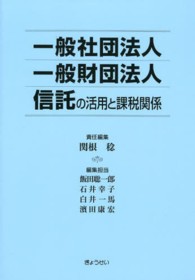Full Description
Challenging dominant views of early childhood language development and knowledge, this thought-provoking volume illuminates the importance of place, the body, and movement in opening space for young children's improvisatory, creative, playful language practices.
Bringing together a rich collection of contemporary research and diverse perspectives, the book centers on the premise that 'where' talk happens—be it spoken, mimed, signed, or assisted through one or more communication tools—is not a neutral backdrop or controllable variable. Rather, it is deeply entangled in the emergence of language from bodies, in how these vocalizations make their way into the world, what they might feel like and set into motion, and how they are received, heard and listened to by other humans and by non-humans. Chapter authors introduce theories about language, body, and place, while also providing examples of what this work may look like in practice.
This book is key reading for those who work with young children and families, including teachers, pre-service teachers studying child development, speech and language therapists, support workers, and those in the arts, cultural and environmental sectors. It is also highly relevant to researchers, literacy education scholars, and anyone who endeavors to think more expansively and critically about language and literacy in early childhood contexts.
Contents
Contents
Book Series Editors' Forward
Foreword: Warda Farah
SECTION I: Introduction
1 Introduction
KHAWLA BADWAN, RUTH CHURCHILL DOWER, WARDA FARAH, ROSIE FLEWITT, RACHEL HOLMES, ABIGAIL HACKETT, CHRISTINA MACRAE, VISHNU NAIR, DAVID BEN SHANNON
SECTION II: Language as bodily and material
2a Language as bodily and material
ROSIE FLEWITT, RACHEL HOLMES, CHRISTINA MACRAE
2b Making time for unruliness in the special education classroom: Resisting the narrowing of neurotypicality in England
YVONNE WILLIAMS and DAVID BEN SHANNON
2c Letting things become what they want to become: Uncertainty, improvisation, and resisting the tyranny of talk
CHARLOTTE ARCULUS
2d Facilitating expressive language through body movements: Clinical implications
MAYA LEELA
2e Speech Bubbles: How play, joy, and storytelling open up expansive possibilities for language
ADAM POWER-ANNAND with ABIGAIL HACKETT
2f Coming together: Roundtable discussion on language as bodily and material
CHARLOTTE ARCULUS, RACHEL HOLMES, MAYA LEELA, CHRISTINA MACRAE, ADAM POWER-ANNAND, DAVID BEN SHANNON, YVONNE WILLIAMS
SECTION III: Place and language
3a Place and Language
WARDA FARAH, VISHNU NAIR, DAVID BEN SHANNON
3b Researching language and place: What is the evidence base?
ABIGAIL HACKETT and DAVID BEN SHANNON
3c Rituals, vocalisations and creating comfortable spaces: A spatialised view of young children's language in museums
ABI HACKETT, CHRISTINA MACRAE, DAVID BEN SHANNON, ROBERT CHESTER, LUCY COOKE, ESTHER HALLBERG, GEORGINA SIMMONS, LAURA SMITH-HIGGINS, SALLY TOON
3d Spaces of Reprieve: An emancipatory practice centring Black and Brown children labelled with communication difficulties
WARDA FARAH and VISHNU NAIR
3e The entanglement between signed language, embodiment, and place
LEALA HOLCOMB
3f Coming together: Roundtable discussion on place and language
WARDA FARAH, ABI HACKETT, LEALA HOLCOMB, VISHNU KK NAIR, DAVID BEN SHANNON
SECTION IV: Language beyond meaning
4a Language beyond meaning
KHAWLA BADWAN, RUTH CHURCHILL DOWER, ABIGAIL HACKETT
4b Beyond 'deficit' or 'lack': Enjoying the richness of language and meaning-making in a complex early childhood classroom
WILLOW SPENCER, JESS CLARKE, DAVID BEN SHANNON
4c How might body-listening open up space for body-languaging?
RUTH CHURCHILL DOWER
4d Who chooses my words?
ANDREA LEE
4e Listening Body
LOUISE KLARNETT
4f Coming together: Roundtable discussion on language beyond meaning
RUTH CHURCHILL DOWER, ABIGAIL HACKETT, ANDREA LEE, DAVID BEN SHANNON
SECTION V: Rights of the Talker
5. The Rights of the Talker. A manifesto for chattering, whispering, translanguaging, not-speaking, non-verbalising, screeching, signing, clicking, twirling, stimming, assistive technology-ing, jumping, shouting, grasping, gasping, dancing, drawing, repeating, refusing, gesturing, glancing, smirking, eye-rolling, whistling......
ABIGAIL HACKETT, KHAWLA BADWAN, RUTH CHURCHILL DOWER, ESTER EHIYAZARYAN-WHITE, WARDA FARAH, ROSIE FLEWITT, KAREN GRAINGER, RACHEL HOLMES, CHRISTINA MACRAE, VISHNU NAIR, DAVID BEN SHANNON








